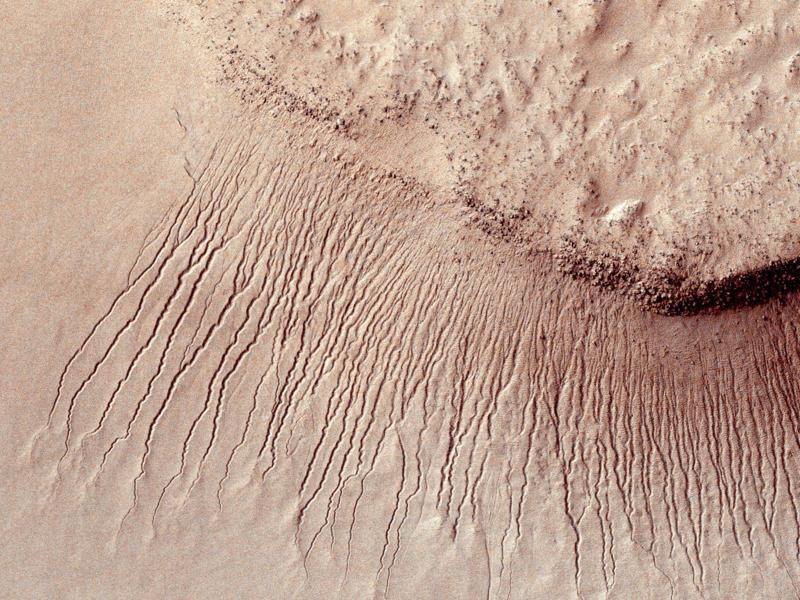Humans on Mars by 2030? All about Nasa’s Red planet announcement
On Tuesday, Rich Zurek, project scientist of Mars Reconnaissance Orbiter (MRO) and Leslie K Tamppari, deputy project scientist of MRO, answered questions posted by the public on a Reddit Ask Me Anything (AMA).

Scientists analysing data from Nasa's spacecraft have said liquid water flows during the summer months on present-day Mars, raising the possibility that the planet long thought to be arid could support life.
Although the source and the chemistry of the water is unknown, the discovery announced on Monday will change scientists' thinking about whether the planet that is most like Earth in the solar system hosts microbial life beneath its radiation-blasted crust.
On Tuesday, Rich Zurek, project scientist of Mars Reconnaissance Orbiter (MRO) and Leslie K Tamppari, deputy project scientist of MRO, answered questions posted by the public on a Reddit Ask Me Anything (AMA).
Here are 15 takeaways from the AMA:
1. What quantity of water are we talking about?
A. We think this is a very small amount of water, maybe just enough to wet the top layer of the surface of Mars. The streaks are 4-5 meters wide and 200-300 meters long.
2. Where does the water come from?
A. We don't know where the water in these hydrated salts come from. That is the next mystery to solve! The leading hypotheses are that (1) the salts are sucking up the water from the atmosphere; (2) that the water is coming from the subsurface. There is certainly more to learn!
3. The water is referred to as "briny" and that it's more fluid than it is water. What does that mean? Would this be something theoretically possible to drink or grow things with? Or would this be the kind of thing that would need purification before it could be used?
A. The salts in the water appear to be perchlorates, so I wouldn't want to drink the water. To be a future resource for humans, you would want to remove the salts.
4. If the Mars rover were to travel to the site of the briny water, what would be the scientific procedure for determining if that water supports life?
A. The Curiosity rover does not have life detection instruments. It would look for confirmation that liquid water was present and how long during the day it was liquid.
5. What does the water taste like?
A. It would be salty, but considering that perchlorate is toxic to humans, you wouldn't want to drink it.


6. The gravity on mars is about 3.711 m/s. Want to know if this much gravity is enough to hold a large amount of water on its surface. What will happen if we pour 200 gallons of water on the surface? Will it evaporate?
A. If you pour pure water on the surface (depending on the time of day) it will either freeze or boil away into the atmosphere. The salts that were talked about in the press release today would keep the water liquid at much lower temperatures. Remember that the temperatures on Mars change by more than 100 degrees Celsius every day.
7. I read that the rover can't approach specific areas (including where the streaks are located) due to risk of infection by Earth microbes. Why is that? What are some examples of microbes that could be living on the rover that you are concerned with infecting the surface of mars?
A. These features are on steep slopes, so our present rovers would not be able to climb up to them. Because liquid water appears to be present, these regions are considered special regions where we have to take extra precautions to prevent contamination by earth life. Our current rovers have not been sterilized to the degree needed to go to an area where liquid water may be present.
8. It was shown back in 2011 that salt water flows may be a seasonal occurrence. What was the final proof for the team that this was happening, and what was your initial reaction to the data?
A. With MRO, we were able to observe a few of these sites at various points within the Mars year, and again the next year. Over time, we saw that the streaks darkened and lengthened during the warm season and faded during the cold season. A benefit of having MRO lasting so long is that we're able to see changes and patterns over time. Our reaction? This is all very exciting! The closer we look at Mars, the more interesting it gets.
9. Is there any evidence of evaporation happening on mars? And do you know where this water came from?
A. New impact craters on Mars sometimes have bright ice exposed in the bottom of the crater. This goes away over a few months. The ice, when exposed, is going from solid to vapor. Evaporation of a briny flow will also occur, so the water needs to be resupplied. We don't know how.
10. What would be the procedure, if life is found on Mars? Would the public be made aware? Who gets told first?
A. Information flows to the public very quickly. If one of our missions here at JPL (Jet Propulsion Laboratory) detected life, we'd notify Nasa headquarters immediately, who would then follow procedures to notify the US government and the public.


11. Given the seasonal nature of today's discovery, does this suggest that there is a hydrologic cycle on Mars?
A. There is a hydrologic cycle on Mars, but typically it involves vapor going to ice (frost) or ice going to vapor. There is no rain in Mars today, but there may have been very early in its history.
12. Why should the average joe care about this? What does this mean for science and space exploration?
A. Liquid water, even if very salty, is still a good place to look for life forms. We don't know how robust martian life (if it exists) could be. Also, water in any form is a resource that future missions could exploit.
A. We are planning to send the InSight lander to Mars in 2016, which will be lander designed to detect Mars-quakes. We also have a rover in development for the 2020s (same basic design as MSL/Curiosity) and Nasa is considering the science that might fly on the next Mars orbiter to be launched sometime after the 2020 rover. The instruments that are chosen to fly are selected because they can accomplish the science goals of the mission, so as the science goals change - with new discoveries - instruments will be proposed and selected accordingly. The food at JPL is actually quite good! Wood-fired pizza, burgers, sandwiches, good salad bar, etc.
14. How long into the future do you think it will be before we can realistically think about sending humans to Mars?
A. Presently, Nasa is looking into the possibility of sending humans to the vicinity of Mars in the early 2030s. In this scenario, the earliest humans to the surface would be in the late 2030s.
15. What's the next step?
A. The next step is to look for more locations where brine flows may occur. We have covered 3% of Mars at resolutions high enough to see these features.
Catch all the Latest Tech News, Mobile News, Laptop News, Gaming news, Wearables News , How To News, also keep up with us on Whatsapp channel,Twitter, Facebook, Google News, and Instagram. For our latest videos, subscribe to our YouTube channel.

























